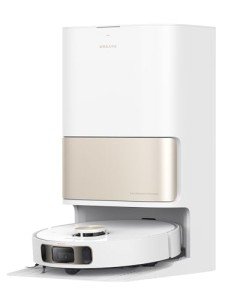The Rise of Robot Vacuum Cleaners in Industrial Settings
Over the last few years, the landscape of industrial cleaning has actually experienced a substantial transformation with the intro of robot vacuum cleaners. These automated gadgets are not just a novelty for homes; they have gotten traction in storage facilities, producing plants, and other industrial environments. robotic vacuum cleaner deals explores the performance, advantages, and considerations of robot vacuum cleaners within the industrial context, while responding to some regularly asked questions.
What are Robot Vacuum Cleaners?
Robot vacuum are automated cleaning devices equipped with advanced sensors and technology that enable them to browse around spaces, find dirt, and vacuum surfaces without direct human intervention. In industrial settings, they are designed to deal with a variety of debris types, assist in regular cleaning schedules, and enhance total operational performance.
Table 1: Key Features of Industrial Robot Vacuum Cleaners
| Function | Description |
|---|---|
| Navigation | Uses LiDAR or camera-based navigation for exact mapping. |
| Size and Design | Compact and robust style to fit in tight areas and endure hard environments. |
| Self-Charging | Automatically go back to its docking station for charging. |
| Dustbin Capacity | Larger dustbin fit for industrial particles sizes and volumes. |
| Programming | Can be configured for scheduling and particular cleaning tasks. |
| Data Collecting | Equipped with sensing units to collect information for maintenance and cleaning analysis. |
Benefits of Robot Vacuum Cleaners in Industrial Settings
The adoption of robot vacuum features a myriad of benefits:
Increased Efficiency:
- 24/7 Operation: Unlike human cleaners, robots can operate all the time, adding to constant tidiness without downtime.
- Time-Saving: Automated cleaning enables employees to concentrate on core tasks rather than cleaning tasks.
Cost Savings:
- Labor Costs: Maintaining a robot vacuum can reduce the requirement for a large cleaning staff, decreasing overall labor expenses.
- Operational Efficiency: With enhanced cleanliness and minimized downtime due to upkeep issues, organizations can save money on operational expenses.
Improved Safety:
- Reduced Risk: By lessening the human participation in harmful cleaning environments, the threat of mishaps is minimized.
- Constant Cleaning: Robot vacuums make sure that areas are regularly cleaned, decreasing slip threats and unhealthy environments.
Increased Flexibility:
- Customizable Cleaning Routes: These machines can be set to clean particular locations or floors, adjusting to changing industrial designs.
- Range of Surfaces: Industrial robot vacuums can manage numerous flooring types, from concrete to tiles, making them flexible.
Environmental Impact:
- Sustainable Cleaning Solutions: Many designs utilize minimal water and ecologically friendly cleaning services, aiding in business sustainability efforts.
Table 2: Industrial Applications of Robot Vacuum Cleaners
| Market | Application |
|---|---|
| Production | Cleaning production lines and assembly locations. |
| Warehousing | Keeping clean and organized storage areas. |
| Food Processing | Making sure tidiness in sensitive areas to meet health standards. |
| Pharmaceuticals | Maintaining ultra-clean environments for production. |
| Logistics and Distribution | Keeping pathways clear for efficient operation. |
Obstacles and Considerations
While the advantages are substantial, businesses need to also think about numerous difficulties:
- Initial Investment: The upfront costs of acquiring industrial robot vacuum can be significant, though long-lasting savings might offset this expenditure.
- Repair and maintenance: Regular upkeep is essential to keep the robotic systems functioning optimally, and repairs can incur extra costs.
- Combination: Businesses may require to incorporate these machines into existing workflows, which can need time and adjustment.
- Training and Support: Staff might need training to effectively handle these machines, particularly when repairing or shows is required.
Frequently Asked Questions About Robot Vacuum Cleaners in Industrial Settings
1. How much do industrial robot vacuum cleaners cost?
The expense can vary from a couple of thousand to 10s of countless dollars, depending on requirements, functions, and brand name.
2. What types of surface areas can they clean?
Robot vacuum appropriate for different surface areas consisting of carpets, tiles, concrete, and even some wood floors.
3. How do they browse intricate industrial environments?
A lot of industrial robot vacuums make use of advanced navigation systems like LiDAR, cameras, and sensors to draw up and adapt to their surroundings for efficient cleaning.
4. Can they clean up large locations without human intervention?
Yes, industrial robot vacuums are created to clean extensive areas with predetermined routes and schedules, efficiently running autonomously.
5. Are these robots environmentally friendly?
Numerous designs focus on efficiency and minimize water usage, making them a more eco-friendly cleaning choice compared to standard methods.
The intro of robot vacuum cleaners into industrial environments represents an exceptional development in cleaning innovation. With their capability to boost performance, minimize labor expenses, and keep security, these automated systems are leading the way for smarter and cleaner industrial operations. While difficulties may exist, the long-lasting advantages and technological developments are motivating for markets looking for to improve their cleaning procedures. As robotic vacuum cleaner best continues to progress, we can anticipate more developments in robot vacuum cleaners that will change industrial cleaning practices much more.

